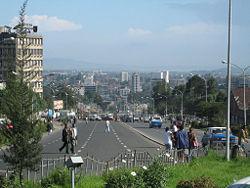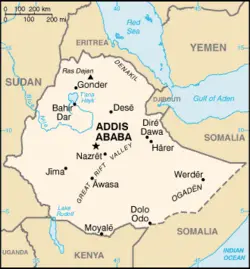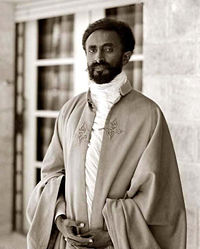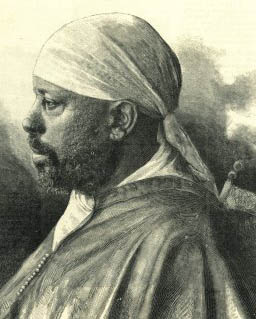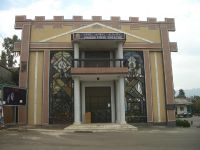Addis Ababa
| Addis Ababa | |
| Map of Ethiopia | |
| Coordinates: {{#invoke:Coordinates|coord}}{{#coordinates:9|38|0||38|42|0||type:city | |
|---|---|
| name= }} | |
| Chartered | Addis Ababa |
| Government | |
| - Mayor | Berhanu Deresa |
| Area | |
| - City | 530.14 km² (204.7 sq mi) |
| - Land | 530.14 km² (204.7 sq mi) |
| Elevation | 2,355 m (7,726 ft) |
| Population (2008) | |
| - City | 3,146,999 |
| - Density | 5,936.2/km² (15,374.7/sq mi) |
| - Urban | 3,146,999 |
| Time zone | East Africa Time (UTC+3) |
Addis Ababa is the capital city of Ethiopia and the African Union and its predecessor, the OAU. It is also the largest city in Ethiopia. With a population of 3,627,934 as of 2007, Addis Ababa is the world's largest city that is in a landlocked country. As a chartered city (ras gez astedader), Addis Ababa has the status of both a city and a state. It is often called the capital of Africa or the "African Capital" due to its historical, diplomatic and political significance for the continent. The city lies at the foot of Mount Entoto, and is home to Addis Ababa University.
Ethiopia has often been called the origin of human kind due to various hominid fossil discoveries like the Australopithecine Lucy. [1][2] Analysis of the DNA of almost 1000 people around the world, led to claims that humans spread from what is now Addis Ababa 100,000 years ago. [3][4]
Geography
The name is sometimes spelled Addis Abeba, which means "new flower" in the Amharic language. Empress Taitu named the city, which is also known by the Oromo language name “Finfinnee”. Other parts of the city were called hora Finfinnee ("hot springs").
The city is located at an elevation of about 8000 feet (2440 meters) above sea level on a plateau that is crossed by numerous streams and surrounded by hills and mountains, in the geographic centre of the country.
Ecologically, Addis Ababa is a grassland biome, which is a climatically and geographically defined area of similar communities of plants, animals, and soil organisms.
The city possesses a complex mix of highland climate zones, with temperature differences of up to 10°C, depending on elevation and prevailing wind patterns. The high elevation moderates temperatures year-round, and the city's position near the equator means that temperatures are very constant from month to month. The temperature in January ranges from a high of 68°F (20°C) to a low of 53°F (12°C).
Rivers and canals Size – land area, size comparison Environmental issues Districts
History
The modern city of Addis Ababa was founded in 1886, by Emperor Menelik II, at the site of a hot spring chosen by Empress Taytu Betul. Menelik, initially a King of the Shewa province, had found Mount Entoto a useful base for military operations in the south of his realm. Entoto, situated on a high tableland, was found to be unsatisfactory because of extreme cold and a shortage of firewood.
Initially, Taytu built a house for herself near the "Filwoha" hot mineral springs, where she and members of the Showan Royal Court liked to take mineral baths. Other nobility and their staffs and households settled the vicinity, and Menelik expanded his wife's house to become the Imperial Palace, which remained the seat of government in Addis Ababa. The name changed to Addis Ababa and became Ethiopia's capital when Menelik II became Emperor of Ethiopia in 1889.
The city grew around the emperor's palace, which was surrounded by the dwellings of his troops and retainers.
In 1905, Emperor Menelik planted numerous eucalyptus trees, imported from Australia, along the city streets. The trees spread and provided a forest cover.
The completion in 1917 of the railway to Djibouti accelerated the city's somewhat haphazard and unplanned growth.
On May 5, 1936, Italian troops occupied Addis Ababa during the Second Italo-Abyssinian War, making it the capital of Italian East Africa from 1936 to 1941. Modern stone houses were built, many roads were paved, a water reservoir was built at Gefarsa in the west, and a hydroelectric station at Akaki to the south.
After the British army and the Ethiopian patriots defeated the Italian army during the East African Campaign in Ethiopia Haile Selassie, who was Emperor from 1930, returned to Addis Ababa on May 5, 1941, and immediately began the work of re-establishing his capital.
Between 1960 and 1970 the population of the city nearly doubled, and new light manufacturing industries were established.
Emperor Haile Selassie helped form the Organization of African Unity in 1963, and invited the new organization to keep its headquarters in the city. The OAU was dissolved in 2002 and replaced by the African Union (AU), also headquartered in Addis Ababa. The United Nations Economic Commission for Africa also has its headquarters in Addis Ababa. Addis Ababa was also the site of the Council of the Oriental Orthodox Churches in 1965.
Government
Arkebe Oqubay was a Mayor of Addis Ababa, Ethiopia. He held office from early 2003 to May of 2005. On March 31, 2005, Arkebe Oqubay was named "African Mayor of 2005" by Broadcasting Network of Africa. Mayor Oqubay lost the mayorship of Addis Ababa in May of 2005 to Berhanu Nega, but after boycotting the parliament Berhanu Nega's C.U.D. or Kinijit party did not take control of the city government. The leaders of the CUD, his opposition party which swept the election in the capital, were later imprisoned and not permitted to assume control of the city. They were pardoned and released after two years in prison.
Though most of the CUD refused to join the parliament, factions of CUD and all the rest of opposition parties joined parliament in 2005. The government has appointed a provisional city government with Berhanu Deresa the acting Mayor.
Economy
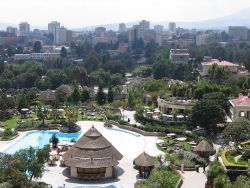
The economic activities in Addis Ababa are diverse. In 2007, some 119,197 people in the city were engaged in trade and commerce; 113,977 in manufacturing and industry, which includes printing industries, and manufactures include footwear, clothing, asbestos and metal products, processed foods, cement, and plywood; 80,391 homemakers of different variety; 71,186 in civil administration; 50,538 in transport and communication; 42,514 in education, health and social services; 32,685 in hotel and catering services; and 16,602 in agriculture, according to official statistics.
A vast open-air market known as the Mercato, on the western side of the city, is the site for trade of leather, metal, and textile goods, from flourishing craft industries, and regional agricultural produce, such as coffee, tobacco, and dairy foods.
Per capita GDP, rank Financial and business services sector Tourism Manufacturing Transport: Road, rail, air, sea
In addition to the residents of rural parts of Addis Ababa, the city dwellers also participate in animal husbandry and cultivation of gardens. Currently 677 hectares of land is irrigated annually, on which 129,880 quintals of vegetables are cultivated.[5]
Many poor Ethiopians from the rural areas come to Addis Ababa as beggars and fill some of the streets. Recently, the number of beggars declined after a government and NGO attempt to move some of them and provide education and jobs. It is a relatively clean and safe city, with the most common crimes being pick pocketing, scams and minor burglary.[6] The city has recently been in a construction boom with tall buildings rising in many places. Also, various luxury services have become available and the construction of shopping malls has recently increased. Some people have labeled the city, "the spa capital of Africa."[7]
Addis Ababa is the hub of a road network, and the terminus of a rail link to the Gulf of Aden port of Djibouti.
Public transportation is through public buses or blue and white share taxis. The taxis are usually minibuses that can sit at least 12 people. Two people are responsible for each taxi, the driver and a weyala who collects fares and calls out the taxi's destination.
The city is served by Bole International Airport, where a new terminal opened in 2003. The old Lideta Airport in the western "Old Airport" district is used mostly by small craft and military planes and helicopters. Addis Ababa also has a railway connection with Djibouti City, with a picturesque French style railway station.
Transportation
Public transportation is through public buses or blue and white share taxis. The taxis are usually minibuses that can sit at least twelve people. Two people are responsible for each taxi, the driver and a weyala who collects fares and calls out the taxi's destination.
The city is served by Bole International Airport, where a new terminal opened in 2003. The old Lideta Airport in the western "Old Airport" district is used mostly by small craft and military planes and helicopters. Addis Ababa also has a railway connection with Djibouti City, with a picturesque French style railway station.
Demographics
The city is populated by people from different regions of Ethiopia. The country has as many as 80 nationalities speaking 80 languages and religious communities including Christian, Muslim, and Jewish.
Based on figures from the Central Statistical Agency of Ethiopia (CSA) published in 2008, Addis Ababa has an estimated total population of 3,147,000, consisting of 1,511,000 men and 1,636,000 women. The CSA estimated that presently there are no rural parts to the city, so 100% of the inhabitants are considered urban dwellers; Addis Ababa contains 23.8% of all urban dwellers in Ethiopia. With an estimated area of 530.14 square kilometers (204.69 sq mi), this chartered city has an estimated density of
- REDIRECT Template:Convert/PD/km2.[8]
These estimates are based on the 1994 census, in which the population of Addis Ababa was reported to be 2.3 million of which 28,149 lived in the rural parts of the city. 51.6% were females, while 48.4% were male.
Almost all the Ethiopian ethnic groups are represented in Addis Ababa due to its position as capital of the country. The major ethnic groups represented are the Amhara (48.3%), Oromo (19.2%), Gurage (17.5%), and Tigray (7.6%), while others constitute 7.4% of the population.[9]
82% of the population are Orthodox Christians, 12.7% Muslims, 3.9% Protestants, 0.8% Catholics, while the remaining 0.6% are followers of other religions (e.g. Hindus, Jews, Bahá'ís, Agnostics, etc.).
Education
Addis Ababa University was founded in 1950 and was originally named "University College of Addis Ababa", then renamed in 1962 for the former Ethiopian emperor Haile Selassie I who had donated his Genete Leul Palace to be the University main campus in the previous year. It received its current name in 1975. Although the university has six of its seven campuses within Addis Ababa (the seventh is located in Debre Zeit, about 45 km/28 mi away), it also maintains branches in many cities throughout Ethiopia. It is the home of the Institute of Ethiopian Studies and the Ethnological Museum. The city also has numerous private colleges including Admas College,Ethiopian Civil Service College and Unity University College.
Other features
Addis Ababa is the headquarters of the United Nations Economic Commission for Africa and the African Union. The fossilized skeleton, and a plaster replica of the early hominid Lucy (known in Ethiopia as Dinkinesh) is preserved at the Ethiopian National Museum in Addis Ababa.
The city is home to the Ethiopian National Library, the Ethiopian Ethnological Museum (and former palace), the Addis Ababa Museum, the Ethiopian Natural History Museum, the Ethiopian Railway Museum and the National Postal Museum.
Notable buildings include St George's Cathedral (founded in 1896 and also home to a museum), Holy Trinity Cathedral (once the largest Ethiopian Orthodox Cathedral and the location of Sylvia Pankhurst's tomb) as well as the burial place of Emperor Haile Selassie and the Imperial family, and those who fought the Italians during the war. There is also Menelik's old Imperial palace which remains the official seat of government, and the National Palace formerly known as the Jubilee Palace (built to mark Emperor Haile Selassie's Silver Jubilee in 1955) which is the residence of the President of Ethiopia. The Hager Fikir Theatre, the oldest theatre in Ethiopia, is located at the Piazza district. Africa Hall is located across Menelik II avenue from this Palace and is where the United Nations Economic Commission for Africa is headquartered as well as most UN offices in Ethiopia. It is also the site of the founding of the Organisation of African Unity (OAU) which eventually became the African Union. Near Holy Trinity Cathedral is the Parliament building, built during the reign of Emperor Haile Selassie, with its clock tower. It continues to serve as the seat of Parliament today. Across from the Parliament is the Shengo Hall, built by the Derg regime of Mengistu Haile Mariam as its new parliament hall. The Shengo Hall was the world's largest pre-fabricated building, which was constructed in Finland before being assembled in Addis Ababa. It is used for large meetings and conventions. Near Bole International Airport is the new Medhane Alem (Savior of the World) Cathedral, which is the second largest in Africa. In the Merkato district, which happens to be the largest open market in Africa, is the impressive Anwar Mosque, the biggest mosque in Ethiopia. Few meters to the southwest of the Anwar Mosque is the Raguel Church, porterying centuries-old magnificent religious harmony and tolerance between Christians and Muslims in Ethiopia. The Roman Catholic Cathedral of the Holy Family is also in the Merkato district.
Other features of the city include the large Merkato market, the Jan Meda Race Ground racecourse, Bihere Tsige Recreation Centre and a railway line to Djibouti. Sport facilities include Addis Ababa and Nyala Stadiums. The 2008 African Championships in Athletics were held in Addis Ababa. The Entoto Mountains start among the northern suburbs. Suburbs of the city include Shiro Meda and Entoto in the north, Urael and Bole (home to Bole International Airport) in the east, Nifas Silk in the south-east, Mekanisa in the south, and Keraniyo and Kolfe in the west.
The city hosts since the We Are the Future center, a child care center that provides children with a higher standard of living. The center is managed under the direction of the mayor’s office, and the international NGO Glocal Forum serves as the fundraiser and program planner and coordinator for the WAF child center in each city. Each WAF city is linked to several peer cities and public and private partners to create a unique international coalition. Launched in 2004, the program is the result of a strategic partnership between the Glocal Forum, the Quincy Jones Listen Up Foundation and Mr. Hani Masri, with the support of the World Bank, UN agencies and major companies.
Sister cities
Notable people
- Nikos Papatakis (1918) Greek film director
Notes
- ↑ Humans Moved From Africa Across Globe, DNA Study Says
- ↑ DNA Links Humanity To One Common Origin: Africa
- ↑ Around the world from Addis Ababa
- ↑ New study proves theory of Human Recent African Origin
- ↑ FDRE States: Basic Information - Addis Ababa (accessed 30 July 2007)
- ↑ Overseas Security Advisory Council - Ethiopia 2007 Crime and Safety Report
- ↑ Addis Ababa the spa capital of Africa
- ↑ CSA 2005 National Statistics, Table B.3.
- ↑ FDRE States: Basic Information - Addis Ababa (accessed 12 March 2006)
External links
- Addis Ababa Photo Gallery
- Addis Ababa on Wikitravel
- Addis Ababa City Administration
- Support for Mayor’s overhaul of Addis Ababa
- Addis Ababa City Council
- Introduction to Addis Ababa
- Photos of Addis Ababa
- Photos Gallery of Addis Ababa
- Schools and Colleges of Addis Ababa
Credits
New World Encyclopedia writers and editors rewrote and completed the Wikipedia article in accordance with New World Encyclopedia standards. This article abides by terms of the Creative Commons CC-by-sa 3.0 License (CC-by-sa), which may be used and disseminated with proper attribution. Credit is due under the terms of this license that can reference both the New World Encyclopedia contributors and the selfless volunteer contributors of the Wikimedia Foundation. To cite this article click here for a list of acceptable citing formats.The history of earlier contributions by wikipedians is accessible to researchers here:
The history of this article since it was imported to New World Encyclopedia:
Note: Some restrictions may apply to use of individual images which are separately licensed.
